 |
CHAMÄLEON + ONJALA OBSERVATORY The Jupiter opposition in June 2019 |
SITEMAP HOME CHAMÄLEON |
|
 |
|||
|
|
|||||||||||
 |
The
Jupiter opposition in June 2019 - General Due to the fact that one of the Team Chameleon was allowed to spend a longer period of time in Namibia in 2019, we were able to record a large number of Jupiteravis. In total we were able to take avis in 64 nights, the first series of pictures is from June 11th, the last from October 3rd. Altogether, several hundred raw-sum pictures came together, the best of which we present here. Jupiter appeared in June with an apparent diameter of 46", in the last images from late September/early October it was only 35.5 arc seconds. The difference in distance between Earth and Jupiter was 190 million kilometres between 10 June and 3 October. At the end of May we received the news that the large red spot (GRF) was subject to strong changes, there was even talk of a possible resolution. We have therefore focused our attention on GRF transits. « "Jupiter and Ganymed on 1st August 2019, Celestron C 14 + Baader Q-Turret Barlowelement , Baader UV/IR pass filter, recording focal length approx. 6.500mm, 300/3.000 frs, ASI 224C |
 The difference in distance between Earth and Jupiter was 190 million kilometres between 10 June and 3 October. Stacking Problems |
« The images on the left show the
changes in the cloud band southeast of the GRF within only 48
hours » The picture on the right shows the comparison of the apparent diameter of Jupiter to the opposition (46") and mid September (35.5"). |
 |
 |
The
first raw avi's from June were edited with Autostakkert 2.1.0.5 by Emil
Kraaikamp. We use this software with the batch mode with best results for our
monochrome moon images. With our Jupiteravis Autostakkert showed strange
stacking errors (see picture on the left). In the raw sum image the error was hardly visible, so it remained unnoticed for a few days. On average, half of all raw avalanche beacons in an evening were affected by the error. We changed/changed computer, software version and recording camera module, but unfortunately we could not verify the cause of the error. Since an email request for help from E. Kraaikamp unfortunately remained unanswered, we used the good old RegiStax 6.1. The disadvantage is that the software does not have a batchmode and therefore all avis |
From the beginning we have taken all raw avalanches with identical acquisition parameters (gain and color balance) with FireCapture, only exposure time and image contrast were adjusted to the corresponding observation conditions. Also, ALL raw avalanche images were treated with identical software and identical parameters like wavelet sharpening and white balance until the final image was ready. In general, 3,000 single images were acquired, of which 300 were stacked avifile each. The color scheme of the finished images was adapted to images taken with Voyager II (see images below). Recording optics was a Celestron C14 in primary focus (f = 3,900mm), together with a ZWO ASI 224C and a Baader IR pass filter. ALL images in the image compilations are shown at a scale of 1: 1, the image orientation is always: South top, East right.
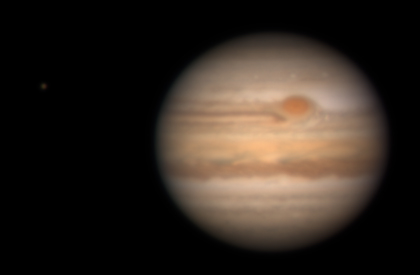 |
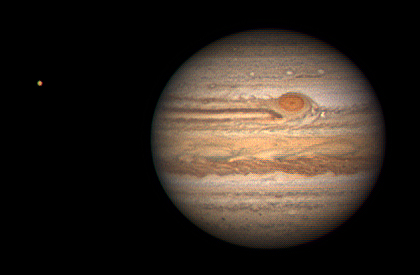 |
| The raw summation picture 300/3.000
frs |
Wavelet sharpening with AviStack |
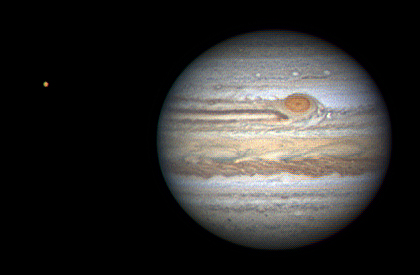 |
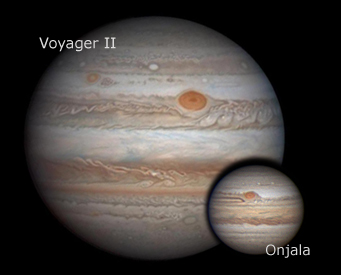 |
| White balance with Photoshop |
Colouring with Voyager II Image |
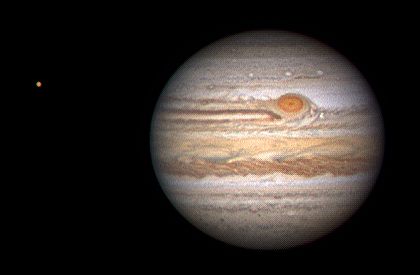 |
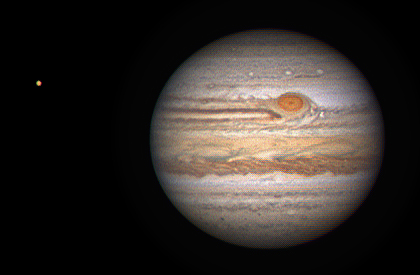 |
| Color correction with Photoshop | Histogram and contrast in Photoshop |
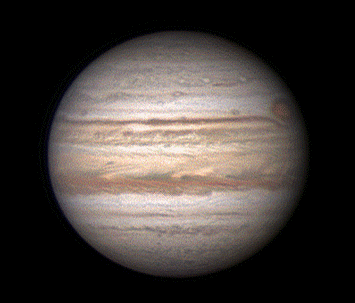 |
The picture series The best seeing window with subarcsecond resolution at our observation site is often in the time shortly before and after sunset, which means that many of the raw avalanches were taken under bright skies. In August we had the "luxury problem" that Jupiter culminated around sunset at an altitude of 89 degrees above the horizon. Due to the dome construction we could not adjust Jupiter at best seeing, the dome gap covered the opening of the C14 and so there are only few pictures from August. Jupiter and GRF in June and July Jupiter and GRF August to October and "best of" GRF "Best of" changes around the GRF from June to September Jupiter with central meridians without visibility of the GRF Jupiter moons, light and shadow plays |
|
 |
 |
 |
 |
 |
 |
 |
| Sun | Moon | Solar System | DeepSky | Widefield | Miscellaneous | Spec. Projects |
